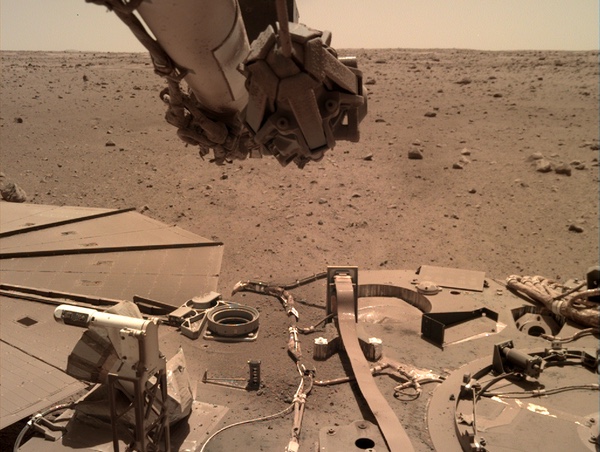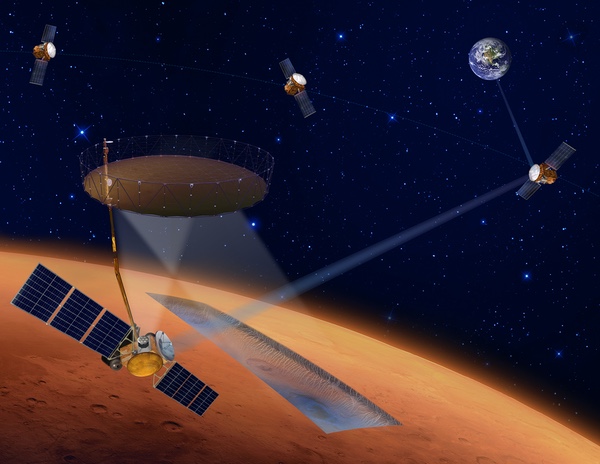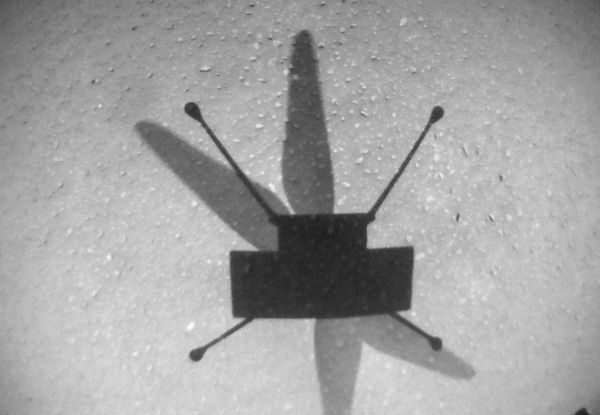Ingenuity, InSight, and Ice Mapperby Jeff Foust
|
| “We’re trying to look at the science applications: what science is enabled by having the aerial dimension added,” Tzanetos said. |
Those rovers and their defunct predecessors—Sojourner, Spirit, and Opportunity—have demonstrated the benefits of mobility in exploration of Mars. They are not, though, the only means of studying the planet, as other spacecraft, mobile and stationary, demonstrate their capabilities. Some, though, are facing new challenges, both self-imposed and beyond their control.
Ingenuity pushes the limits
Two months ago, the small helicopter Ingenuity was moving into a new phase of its mission. After completing a series of flawless technology demonstration flights, NASA decided to keep Ingenuity going by extending its mission with a series of “operations demonstration” flights to show how it could support the Perseverance rover (see “The little Mars helicopter that could”, The Space Review, May 3, 2021).
The switch from technology demo to operations demo took place after the helicopter made four flights in 12 days in the latter half of April. Since then, it’s made five more, most recently on Sunday, when the helicopter flew for 166 seconds, traveling about 625 meters, far longer than any previous flight. That trip allowed scientists to use Ingenuity to scout a region called Séítah whose rippled terrain is too dangerous for Perseverance to cross.
Ingenuity’s flights won’t end any time soon, assuming the helicopter remains in good health. “That is going to continue for at least few more months, with a cadence of a couple of flights” per month, said Ken Farley, Mars 2020 chief scientist, at a June 21 meeting of the Mars Exploration Program Analysis Group (MEPAG). “That is the level that we can easily make this coordination work.”
Teddy Tzanetos, operations lead for Ingenuity at JPL, said later at the meeting he expected the team to push Ingenuity even harder: flights lasting up to three minutes and going as far as one kilometer. “That would really be pushing the limit of what the technology demonstrator is capable of,” he said.
As Ingenuity continues to fly—“many, many more” times, Tzanetos said—some are looking ahead to what comes next. At the MEPAG meeting, he described one concept under study called the Mars Science Helicopter. With a mass of 30 kilograms, it could carry five kilograms of science payloads for distances of up to 10 kilometers. Ingenuity, by contrast, weighs in at just 1.8 kilograms.
“We’re trying to look at the science applications: what science is enabled by having the aerial dimension added,” he said. That includes places inaccessible to rovers, like caves or crater walls, or “special regions” of astrobiological interest where a helicopter could avoid contamination.
It’s unclear, though, exactly when something like a Mars Science Helicopter could fly to, and on, Mars. The only surface mission NASA is currently planning is the Sample Retrieval Lander, the next phase in the overall Mars Sample Return campaign that will collect the samples cached by Perseverance and launch them into orbit. NASA officials had previously ruled out flying a helicopter of some kind on that mission.
| InSight is now in an extended mission that NASA has funded through the end of 2022, Banerdt said, “if we can stay alive for that long on Mars.” |
A white paper that Tzanetos and others submitted as part of the ongoing planetary science decadal survey suggested that a Mars helicopter could fit in a range of mission categories, including competed programs like Discovery and New Frontiers. A scaled-down version of the helicopter, still more capable than Ingenuity, “is sufficiently low mass and low volume that it should be considered in all future launch opportunities to Mars’ surface,” the paper concluded.
 A recent image from the InSight lander shows the accumulation fo dust on its solar arrays, sharply reducing the power they produce. (credit: NASA/JPL-Caltech) |
InSight’s fading future
Ingenuity’s relative positive future stands in contrast with another NASA mission, the InSight lander. It’s been on the surface since November 2018, but is best known for the struggles its team faced trying to deploy a subsurface probe to measure the planet’s internal heat flow. That “mole” got stuck only about 30 centimeters before the surface, far short of the desired depth of five meters, and NASA finally halted in January long-running efforts to deploy the mole.
InSight’s other main instrument, a seismometer, has been working well, but the mission is facing another, perhaps fatal threat: a loss of power. The two solar panels have gradually accumulated dust and, unlike the Spirit and Opportunity rovers, have not experienced “cleaning events” that removed dust and restored power levels.
“The dust accumulation on the solar arrays has been considerable. We have about 80% obscuration of the arrays,” said Bruce Banerdt, principal investigator for InSight at JPL, during the MEPAG meeting. Energy levels have dropped from nearly 5,000 watt-hours per Martian day at the start of the mission to less than 700 watt-hours now.
Another factor in the current decline is that Mars is approaching aphelion in its orbit around the Sun. There had been concerns that, near aphelion, the mission would have to turn of the seismometer after already curtailing operations of some secondary instruments, such as a weather station.
In a bid to restore some power, engineers tried an ingenious approach. They used the lander’s robotic arm to scoop up some sand and then pour it out upwind of one of the panels. That wind caused some pebbles to strike the panels and bounce off, in the process removing dust: a technique called saltation.
The first saltation test restored about 25–30 watt-hours of energy to the lander, Banerdt said. Later attempts were not as helpful, but overall the saltation efforts “bought us a little bit of headroom that we didn’t have before” that might allow the seismometer to stay on through aphelion, or at least minimize the time it is shut down.
| NASA’s proposed budget line for Mars Ice Mapper is small: just $15 million in 2022 and $155 million total sought between 2022 and 2026. |
InSight will get a break after aphelion, but only a temporary one. By April of 2022, Banerdt said the combination of increased dust on the panels, more dust in the atmosphere because of the changing seasons, and orbital geometry will cause power production to drop again, this time below the “survival level” required to operate the lander. “Unless we get a fairly significant increase in our solar array output, we’re likely to end our mission sometime around that time next year,” he said.
Some observers have criticized the mission for not considering this possibility and thus have mitigation measures (and, no, the Ingenuity helicopter is too far away to fly over and use its rotors to clean the panels.) But, Banerdt noted, the solar panels were sized to ensure they would produce enough power for its primary mission of one Martian year, which it has exceeded. InSight is now in an extended mission that NASA has funded through the end of 2022, he said, “if we can stay alive for that long on Mars.”
 An illustration of the Mars Ice Mapper mission, flanked by three data relay satellites. NASA’s plans now call for development of only Mars Ice Mapper and not the relay satellites. (credit: NASA) |
Mapping ice on a small budget
A criticism of NASA’s Mars exploration program expressed in recent years is the paucity of future missions. Beyond the Sample Retrieval Lander, there is EscaPADE, a smallsat mission to study the interaction of the solar wind with the tenuous Martian atmosphere. That mission was to fly as a secondary payload on the Psyche mission launching in 2022, but lost its ride when the Psyche mission’s launch vehicle and trajectory changed. (It recently found new life working with Rocket Lab, using that company’s Photon bus on a redesigned version of the twin smallsats that could launch in 2024.)
The only other mission in consideration is the International Mars Ice Mapper mission, an orbiter with a focus more on preparation for future human exploration than on science. That spacecraft would use a radar to look for subsurface ice deposits that could be targets of later human missions (see “The future of Mars exploration, from sample return to human missions”, The Space Review, December 7, 2020.)
As the name suggests, the mission will feature contributions from several international partners: Canada will provide the radar, Japan the spacecraft bus, and Italy the spacecraft’s communications subsystem. NASA will largely be the system integrator and handle the launch of the spacecraft, no earlier than 2026.
At the MEPAG meeting, Eric Ianson, director of NASA’s Mars Exploration Program, played up milestones for the mission such as being included in the fiscal year 2022 budget proposal released in May. NASA’s Goddard Space Flight Center will also be the lead “pre-project” center for the mission.
However, that budget line is small: just $15 million in 2022 and $155 million total sought between 2022 and 2026. Ianson said one item that came out of a recent meeting that selected Goddard as the lead center was to “better define NASA’s role in the partnership.”
The ambitions of Mars Ice Mapper have also narrowed. When agency officials talked about it last year, they also mentioned a network of relay satellites that could significantly increase the volume of radar data the spacecraft returned and could potentially support other missions. “For right now, we’re placing our focus on the synthetic aperture radar spacecraft activities,” Ianson said. “It is possible in the future we’ll be returning to the relay network.”
He added that it’s possible NASA could revisit the relay network concept. That could benefit Mars Ice Mapper, not to mention current and future rovers—and maybe helicopters, too.
Note: we are using a new commenting system, which may require you to create a new account.
